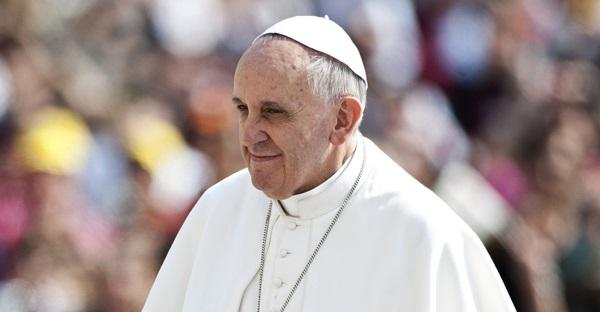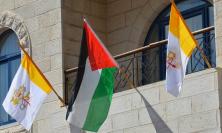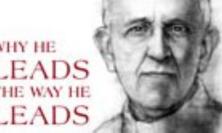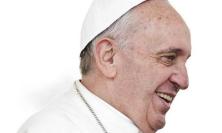During his recent pilgrimage to the Holy Land, Pope Francis issued a remarkable invitation to Palestinian President Mahmoud Abbas and Israeli President Shimon Peres to join him in an encounter of prayer in the Vatican. Ahead of this historic meeting, which takes place on Sunday 8 June, David Neuhaus SJ reflects on the ecumenical, interreligious, political and pastoral dimensions of the pope’s presence in the Holy Land.
At the end of Pope Benedict XVI’s visit to the Holy Land in 2009, he remarked that the Separation Wall was, ‘one of the saddest sights for me during my visit to these lands’. It is sadder still that this is just one among many walls – political, social, economic, ethnic and religious – that define the delicate coexistence of Jews, Muslims and Christians, Israelis and Palestinians, Jews and Arabs in a region that has been plagued by conflict for centuries. For those who live in their shadow, walls obscure the horizon and prevent the possibility of imagining a different tomorrow: a tomorrow of justice, peace, pardon, reconciliation and fraternity.
The arrival in May 2014 of Pope Francis on a three-day pilgrimage to the Holy Land, which took in three countries – Jordan, Palestine and Israel – raised levels of anxiety in the region. He was already known to be someone who does not always respect established walls and their concomitant status quo. There were many questions as to if and how his voice would be heard during this pilgrimage: would his authentic witness and his prophetic imagination be stifled by a whirlwind itinerary that left no time for his well-known (and feared) spontaneity? Would his refusal of suffocating security measures mean that the realities of life in the Holy Land world would be kept at a distance from him?
With determination and courage, Pope Francis accomplished during his three-day pilgrimage a spiritual assault on the walls behind which the residents of the Holy Land are imprisoned. He did not come to impose but rather to propose a way of seeing, experiencing, listening, speaking and acting that would release the imaginations that had been enclosed by these walls. I would like to propose four levels on which this happened: the ecumenical level, the interreligious level, the political level and the level of Christian witness.
Pointing to the ecumenical possibilities
From the outset, Pope Francis put his encounter with Patriarch Bartholomew, the Greek Orthodox Ecumenical Patriarch of Constantinople, at the centre of his pilgrimage. His primary motivation, as he said when he announced his visit to the Holy Land, was to commemorate the courageous meeting between Pope Paul VI and Patriarch Athenagoras in 1964 and to push Catholic-Orthodox rapprochement forward. The magnificent scenes of the embrace of the two spiritual leaders – their greeting in the courtyard of the Church of the Resurrection, their standing alongside one another confessing their shared faith before the empty tomb, their veneration together of the place of the Crucifixion – are at the epicentre of this pilgrimage. It was standing in front of the empty tomb of Christ that Pope Francis clearly and unequivocally defined the vocabulary, the grammar, the syntax of his prophetic imagination:
Let us not allow ourselves to be robbed of the basis of our hope, which is this: Christòs anesti! … We need to believe that, just as the stone before the tomb was cast aside, so too every obstacle to our full communion will also be removed. This will be a grace of resurrection, of which we can have a foretaste even today… Every time we reflect on the future of the Church in the light of her vocation to unity, the dawn of Easter breaks forth!
This language frames the image of the embrace of two men who see in one another brother, friend and fellow disciple, even after centuries of division and polemic, rejection and exclusion. The past and the present are not thrown aside in an impulsive spiritual act, but neither are they permitted to blind one to the horizon that is revealed when God sends His Word and His Spirit on a mission of forgiveness, healing and reconciliation. This was not just a commemoration of the heroic embrace of Paul VI and Athenagoras, but also the iconic representation of what is possible if we have faith, a map of where we must head together, hand in hand.
In a moment of encounter, between himself, Patriarch Bartholomew and all the heads of the Churches in Jerusalem, Pope Francis provided a key according to which all of the other stations in his pilgrimage could be understood: a beautiful vision beckons to us on the horizon beyond the walls we have built, but to get there we must be willing to come out of ourselves and move towards the ‘other’.
Pointing to the interreligious possibilities
Pope Francis followed the example of his predecessors, Saint John Paul II and Pope Benedict XVI, in visiting both the Muslim and Jewish religious authorities in Jerusalem. Like them, he also paid his respects at the Dome of the Rock and at the Western Wall. Those he encountered spoke to him in strong tones about who they are, as Jews and as Muslims, and about how much they have suffered. In words that residents of the Holy Land recognise all too well, each speaker told of how God lives on his side of the wall and shares his vision of those on the other side.
The pope listened intently and he seemed pained by the suffering of those addressing him, Muslim or Jew, Palestinian or Israeli. His own words, though, were not an answer in kind but rather an attempt to open up the possibilities for encounter. Like them, he brought God into the picture – not a God who is chained to a cause but a God who loves all God’s children and is in pain that they seem to ignore the possibilities God seeks to show them.
Nowhere was this message clearer than in the pope’s words at Yad VaShem, the memorial to the six million Jews who perished during the Shoah. This was not a discourse to his Jewish brothers and sisters but rather, standing alongside them, he addressed his words to God. He reminded one and all that in that place, it is not God who is absent but rather the humanity of persons. With urgency, the pope shared with his brothers and sisters the response that God made to his anguished prayer, giving God a voice in the silence:
Adam, who are you? I no longer recognize you. Who are you, o man? What have you become? Of what horror have you been capable? What made you fall to such depths? Certainly it is not the dust of the earth from which you were made. The dust of the earth is something good, the work of my hands. Certainly it is not the breath of life which I breathed into you. That breath comes from me, and it is something good (cf. Gen 2:7). No, this abyss is not merely the work of your own hands, your own heart… Who corrupted you? Who disfigured you? Who led you to presume that you are the master of good and evil? Who convinced you that you were god? Not only did you torture and kill your brothers and sisters, but you sacrificed them to yourself, because you made yourself a god.
His colloquy ended with a cry for mercy. The pope had insisted that this was a pilgrimage, a religious and spiritual journey, and indeed at this place, commemorating the horror that humans are capable of generating, the pope directed the attention of all those who heard him to God. Just before speaking these words, the pope met six Holocaust survivors: he kissed their hands, hands anointed by suffering, hands that pointed to what humans are capable of doing when idols take God’s place.
Rabbi David Rosen, noted authority on the dialogue between the Catholic Church and the Jewish people, lamented that the pope had missed the chance to bring Jews and Muslims together with Christians. Was this really a missed opportunity? Both Popes John Paul II and Benedict XVI had indeed participated in such interreligious meetings in the Holy Land, but these meetings had either been upset by explosions of rage or had been orchestrated to create a false impression of interreligious dialogue; they had done little to promote real interreligious encounter on the ground. This time, the pope’s focus was on the ecumenical encounter with Patriarch Bartholomew rather than on the meetings with Jews and Muslims, yet Pope Francis still had two interreligious surprises up his sleeve.
The first surprise was revealed shortly before the pilgrimage set off: Pope Francis had decided to invite two friends from his time as Archbishop of Buenos Aires to join the pilgrimage. The presence of Rabbi Abraham Skorka, rector of the Conservative Rabbinical Seminary, and Professor Omar Abboud, former secretary-general of the Islamic Centre, gave an interreligious character to the entire pilgrimage, which came across most strongly at the Western Wall. As the pope ended his moment of solitary prayer in front of the towering Wall, he was embraced by his two friends. A pope, a rabbi and a shaykh embracing at this holy site: another image that opened up possibilities on the horizon, beyond the walls. There were no words here but simply an icon of friendship, genuine and emotional, offered to a world that has limited its thinking about the Holy Land to the divisions between Jews, Muslims and Christians.
The second surprise came when the pope announced after the Mass in Bethlehem that he was inviting President Mahmoud Abbas and President Shimon Peres to an ‘encounter of prayer’ in the Vatican. This invitation would be repeated in Israel. The encounter would not take place in a land too divided to make space for it, but rather, ‘in my home in the Vatican’. In the pope’s words, ‘All of us – especially those placed at the service of their respective peoples – have the duty to become instruments and artisans of peace, especially by our prayers.’ This was not an attempt to upstage the political leaders and their diplomatic initiatives but rather an attempt to bring God into the story, so that God might be able to reveal possibilities of encounter. In Middle Eastern discourse, the word ‘God’ is too often employed in support of the cause of the one who speaks the word and as a potent weapon against his enemies. However, can those who invoke God instead come before God as Creator in thanksgiving, beg God’s forgiveness in a sincere confession and intercede for all of creation? Can they do this with a heightened awareness that all are God’s children? Can the ‘God’ used as an instrument to batter one’s foe be revealed as the one Father of all God’s children?
Pointing to the political possibilities
On the Wednesday before the beginning of his pilgrimage, Pope Francis told the crowds gathered for the weekly General Audience in the Vatican that the second reason for his visit, after commemorating the meeting between Pope Paul VI and Patriarch Athenagoras, was ‘to pray for peace in this land that has suffered greatly. I ask you for your prayers for this trip.’ It is this second reason that creates the link between the religious and the political. The pope’s pilgrimage certainly had its ‘political moments’, some discreet and some as loud as the trumpets blowing before the walls of Jericho.
One such loud moment was his heartfelt cry of anguish against the arms dealers, who are profiting from the bloodshed in Syria,
I ask myself: who is selling arms to these people to make war? Behold the root of evil! Hatred and financial greed in the manufacturing and sale of arms. This should make us think about who is responsible for this situation, for providing arms to those in conflict and thereby sustaining such conflict. Let us think about this and with sincere hearts let us call upon these poor criminals to change their ways.
These words were part of the pope’s address to the refugees in the Maghtas, the site of the baptism of Jesus in Jordan, and they echoed the cry of John the Baptist in this place: ‘Repent!’
Another politically significant moment came during Pope Francis’ address to President Mahmoud Abbas in Palestine: the pope referred to his host country as ‘the State of Palestine’ rather than as ‘the Palestinian Authority’. Since the UN’s recognition of Palestine as a non-member observer state in November 2012, few countries have acted consistently and referred to ‘the State of Palestine’, preferring to follow the lead of two of the states who opposed this move, the United States and Israel, and talk of ‘the Palestinian Authority’. The pope’s statement, therefore, was merely truthful, but may have broken political ground, even if his primary intention was not to do so.
Making his way to Manger Square for Mass, Pope Francis stopped the popemobile and got out to pray at the Separation Wall, the huge concrete edifice built by Israel in the name of security. He sought here, too, to bring God into the picture; as he prayed, he laid his head against the wall, touching a profound source of suffering for the Palestinians he was visiting. When in Israel the following day, he laid his head on the wall of the monument created to commemorate the victims of Palestinian terrorism, and he uttered his heartfelt condemnation of all acts of terrorism. For the pope, this was probably less about media balance and diplomatic tightrope-walking than about listening to his hosts and then respecting them enough to speak the truth as he saw it.
The pope had insisted that he would not lunch with patriarchs, bishops and other ecclesial or political dignitaries, but rather that he would share his table with the poor and marginalised. Invited to eat with Pope Francis were those suffering the direct consequences of occupation and discrimination: families whose village had been destroyed, whose lands had been confiscated, whose children languished in prison or in exile, who cannot receive residency or permits. He also met dozens of children on the outskirts of the Deheisheh refugee camp and he listened intently to the young boy who recounted the tale of Palestinian suffering. There were no dignitaries present, no official discourses, and the pope looked relaxed surrounded by the children of refugees. Speaking to them, he warned them that focusing solely on the past, with its wounds, would obscure the possibilities of the future:
Never let the past determine your life. Look forward always. Work and struggle to obtain what you want. However, know one thing, one cannot be victorious over violence through violence. One can only be victorious over violence with peace…
The pope did not simply repeat well-rehearsed formulae for peace as do most political and diplomatic leaders who visit the area. He was insisting on what the prophets repeat: justice and righteousness are necessary because without them there can be no real peace. ‘They dress the wound of my people as though it were not serious. “Peace, peace,” they say, when there is no peace’ (Jeremiah 6:14, 8:11). Throughout his pilgrimage, he sought a way to make the possibilities that God opens up on the horizon a perceived reality. Speaking to President Abbas in Bethlehem, he said:
The time has come for everyone to find the courage to be generous and creative in the service of the common good, the courage to forge a peace which rests on the acknowledgment by all of the right of two States to exist and to live in peace and security within internationally recognized borders.
Generosity, born of an open heart, and creativity, born of an unshackled imagination, are threats to walls that see any generous ceding to the demands of others as weakness and creative inspiration as irresponsible.
Faced with walls and their overwhelming formative influence on how people in the Holy Land speak and act, Pope Francis single-mindedly presented a counter-image: a horizon of possibilities, constantly opened up by the faithful God, whose love binds this wounded humanity together as one family.
Pointing to the possibilities for Christian witness
Pope Francis also came to the Holy Land as pastor of his flock. The four homilies addressed to the Christian faithful (at the Masses in Amman, Bethlehem [Manger Square] and Jerusalem [Cenacle], and the meeting with the religious men and woman at Gethsemane) were exhortations to the Christians to be ‘salt and light’ in their societies, witnesses to the possibilities on the horizon, builders of bridges to replace the walls.
He called on the Christians to take up the yoke of discipleship and go out as witnesses to the Risen Lord. Intimately and painfully aware of the constraints on Christian life in the Holy Land and throughout the region, the pope insisted that the Christians carry out their mission with courage and joy.
Two brief extracts from Pope Francis’ homilies summarise the prophetic imagination that characterised his pilgrimage, and which he wants to pass on to the Church in the Holy Land and the world. We are to go out towards the horizon, bringing down walls and pointing to the possibilities opened up by God:
Let us ask the Spirit to prepare our hearts to encounter our brothers and sisters, so that we may overcome our differences rooted in political thinking, language, culture and religion. Let us ask him to anoint our whole being with the oil of his mercy, which heals the injuries caused by mistakes, misunderstandings and disputes. And let us ask him to send us forth, in humility and meekness, along the demanding but enriching path of seeking peace. (From Pope Francis’ homily in Amman)
And from the pope’s homily in Jerusalem:
Here the Church was born, and she was born to go forth. From here she set out, with the broken bread in her hands, the wounds of Christ before her eyes, and the Spirit of love in her heart…. These horizons are opened up … the horizons of the Risen Lord and his Church.
Fr David M. Neuhaus SJ serves as Latin Patriarchal Vicar within the Latin Patriarchate of Jerusalem. He is responsible for Hebrew-speaking Catholics in Israel as well as the Catholic migrant populations. He teaches Holy Scripture at the Latin Patriarchate Seminary and at the Salesian Theological Institute in Jerusalem and also lectures at Yad Ben Zvi.






